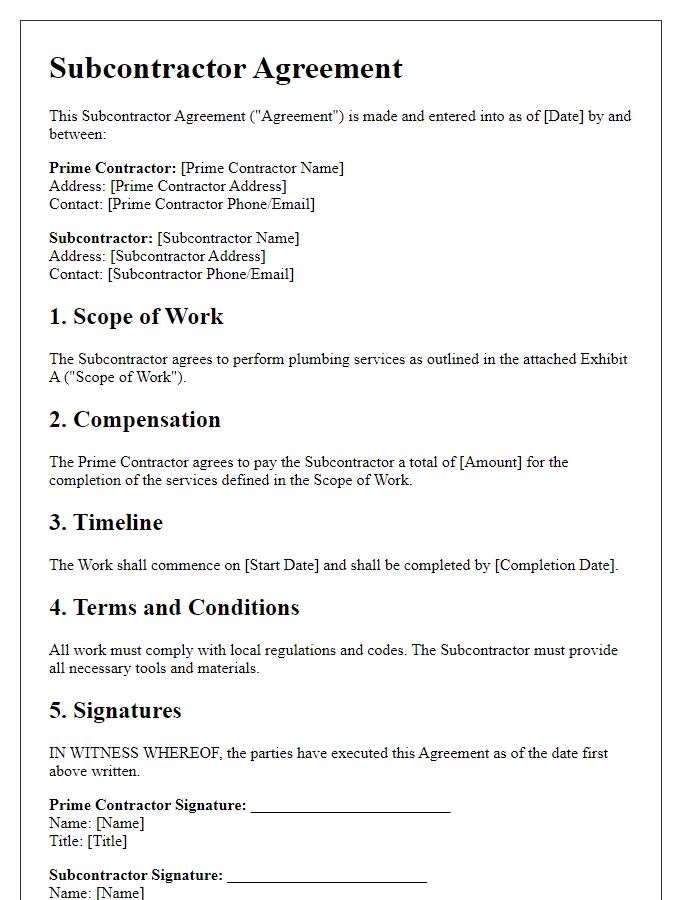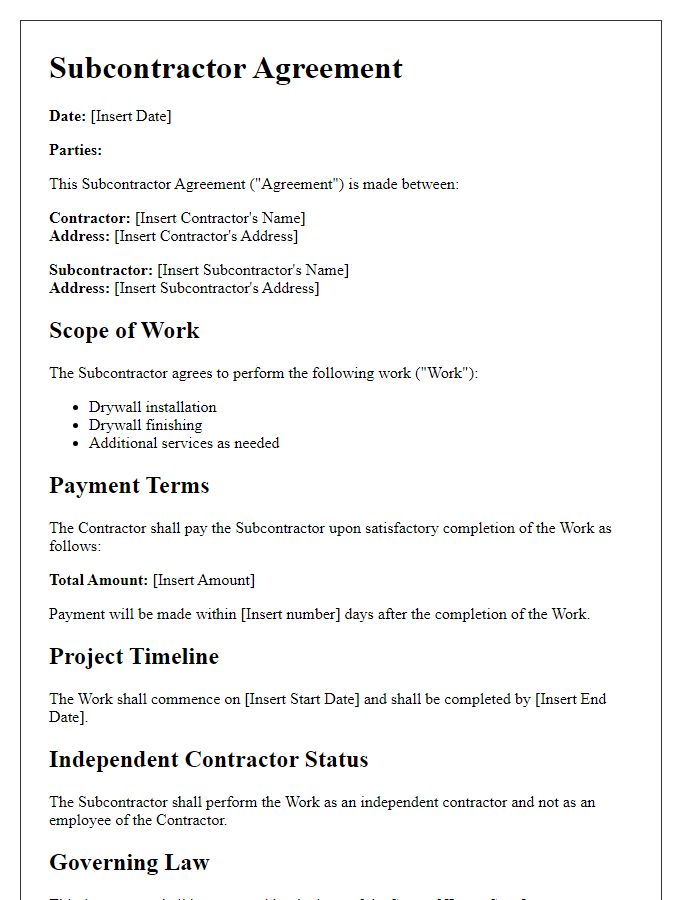Are you navigating the complexities of hiring subcontractors for your construction projects? A well-structured subcontractor agreement is essential to establish clear expectations and protect your interests. In this article, we'll provide you with a comprehensive letter template that outlines key elements to include, ensuring a smooth and successful partnership. So, let's dive in and explore how to craft the perfect subcontractor agreement!

Scope of Work
The Scope of Work outlines the specific tasks and responsibilities assigned to the subcontractor in a construction project, ensuring clarity and mutual understanding of expectations. This section typically includes detailed descriptions of each task, such as excavation, framing, electrical installation, plumbing services, and finishing work. It may also specify project timelines, key milestones, and compliance with safety regulations set forth by the Occupational Safety and Health Administration (OSHA). Additionally, the location of the project, often referred to by its address or project name, provides context for the geographical area of operation. The subcontractor must also adhere to quality standards set by both the general contractor and project specifications, ensuring that materials meet industry codes and verifications. Any changes, modifications, or additional work outside the initial Scope of Work may result in prompt discussions regarding cost adjustments and scheduling impacts.
Payment Terms
Payment terms in a construction subcontractor agreement establish the financial framework for the project. These terms detail the specific schedule for payments, often aligned with project milestones, such as the completion of various phases (foundation, framing, etc.) or the submission of invoices. For example, a typical agreement may stipulate a 30% down payment upon contract signing, followed by additional payments of 30% upon completion of framing and 40% upon project completion. Payment can be contingent on the contractor's approval of work quality and compliance with local building codes. Late payment penalties might also be included, often a percentage of the overdue amount for each week of delay, incentivizing timely payments. Clear documentation requirements for invoices and any necessary supporting documents, such as lien waivers, further ensure compliance and transparency throughout the construction process.
Timeline and Milestones
The construction subcontractor agreement establishes a detailed timeline consisting of key project milestones to ensure smooth project progression. Each milestone represents significant phases, such as the initiation date--identified as January 15, 2024--in which groundwork activities commence at the construction site located at 123 Main Street, Springfield. Following the initiation, the foundation laying is expected to be completed by March 1, 2024, ensuring readiness for subsequent phases. Framing completion is scheduled for May 1, 2024, marking another critical milestone prior to the installation of electrical systems by June 15, 2024. Final inspections and approvals by relevant authorities are planned for July 30, 2024, culminating in final project delivery expected on August 15, 2024. Each milestone will include specific performance criteria to measure fulfillment and adherence to the established timeline, reinforcing the commitment to efficiency and quality throughout the construction process.
Liability and Insurance
A construction subcontractor agreement delineates the responsibilities and protections for parties involved, especially concerning liability and insurance. Subcontractors, for instance, are typically required to carry General Liability Insurance (with coverage limits often starting at $1 million per occurrence), ensuring protection against bodily injury or property damage claims during construction projects. Additionally, specific endorsements may be mandated, such as those covering completed operations or contractor's pollution liability, particularly for projects in sensitive environments like urban areas or near water bodies. Workers' Compensation Insurance must also be established, complying with state laws--average rates can vary significantly, often ranging from $0.75 to $2.50 per $100 of payroll, depending on the trade and jurisdiction. The agreement must address indemnification clauses, which protect the contractor from liabilities that arise directly from the subcontractor's negligence, ensuring financial security. Furthermore, adherence to local regulations regarding subcontractor insurance provisions in places like Texas or California must be explicitly stated to avoid legal pitfalls. Comprehensive documentation of all insurance certificates is essential for compliance and risk management, reinforcing the contractual relationship between the primary contractor and subcontractor.
Dispute Resolution
Dispute resolution mechanisms in construction subcontractor agreements are crucial for maintaining project timelines and relationships. Mediation serves as an initial step involving a neutral third-party facilitator, aiming for amicable resolution without legal escalation. Arbitration often follows, offering a binding decision from an appointed arbitrator, which can save time compared to court litigation. Key timelines, such as 30 days for mediation requests and 60 days for arbitration claims, ensure prompt resolution. Locations chosen for mediation or arbitration, frequently in neutral venues within the jurisdiction of the project site, facilitate convenience and reduce travel costs. Documentation essential for dispute resolution includes contracts, correspondence, and change orders, ensuring all parties have a clear understanding of obligations and agreements. Engaging legal counsel familiar with construction law enhances the effectiveness of dispute resolution strategies.
Letter Template For Construction Subcontractor Agreement Samples
Letter template of subcontractor agreement for residential construction project.

Letter template of subcontractor agreement for commercial building services.

Letter template of subcontractor agreement for renovation and remodeling services.

Letter template of subcontractor agreement for plumbing services in construction.

Letter template of subcontractor agreement for landscaping and site preparation.

Letter template of subcontractor agreement for HVAC installation and maintenance.

Letter template of subcontractor agreement for drywall and finishing services.










Comments